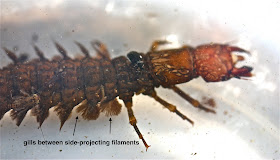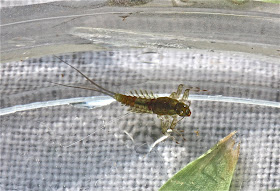Yes, yes, I know -- we all want to see those beautiful mayflies and stoneflies and caddisflies, but they do share the streams with some rather scary characters. Megaloperta, Corydalidae (Corydalus cornutus, I'm told) -- a Hellgrammite, or Fish Fly, or Dobson Fly to most of us who've been seeing them since we were kids. This is 2 1/2" - 3" long -- a big one -- so if you want to grab it, I'd advise you to stay away from those "pincers" on the front of the head. A closer look:
If you're this close, you're too close! They will grab your fingers -- and it hurts! But they're not all this big at this time of year. In fact, right now, you can find infants and toddlers and teens -- as well as these monsters that are preparing to hatch. (Have a look at recent entries from the Mechunk Creek and the Rivanna River at Milton.) Some others that I've found this summer -- a baby and then something like a teen.
I took a couple of photos of this big boy today -- well, could be a girl I guess (?) -- where we can notice some interesting things. First...
You can get an idea of the size of this baby by noting the other nymphs in the photo: two flatheaded mayflies, a brushlegged mayfly, and a young hellgrammite that looks like it's climbing aboard! You can also see (I encourage you to click on the photo to enlarge it) the two claws on each anal proleg that help us ID this critter, no matter how small it might be. And finally, you can make out the "frilly gills" that can be found between each of the filaments on abdominal segments 1-8 and 10. We often miss seeing those "gills," because they won't be in use unless the hellgrammite is in water that's deep enough for it to draw the oxygen out of the water. Here's a photo that helps us to see them a little bit better.
Of course, this is not the only thing that I saw today. I saw a lot -- and I do mean a lot -- of brushlegged mayflies. Most were in leaf packs which are already starting to form in the stream. There were also a lot of flatheaded mayflies -- mostly genus Maccaffertium. But I did find a few Heptagenias -- so they do live in streams other than the Moormans!
I've discovered that this is Heptagenia marginalis, and one of the keys to identification is the "oblique" black lines on the margins of the abdominal segments (click to enlarge). These hatch in July, August, and September. Note that the wing pads on this one are quite a bit longer than those on the nymph that I found last week.
I also found more Whirligig beetles, some Dryopid beetles (on leaves and pieces of bark), lots of netspinners and fingernet caddisflies, and a handful of small minnow mayflies. All of the small minnows were Baetis in terms of the genus. Earlier in the summer, I found both Acentrella and Baetis nymphs here: the Acentrellas seem to be gone (they were looking pretty mature back in June). A couple of pix (note the three tails).
I also found one spiny crawler, genus Serratella -- but the photos I got aren't really worth showing.
Below, Buck Mt. Creek in the low flow of summer.


























































